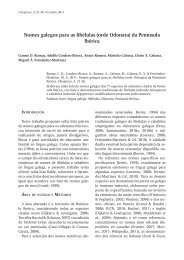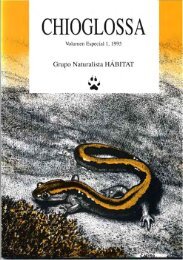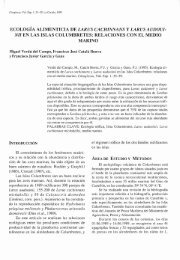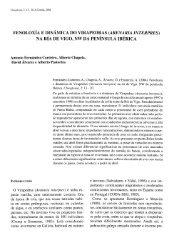1 Tr - Chioglossa
1 Tr - Chioglossa
1 Tr - Chioglossa
Create successful ePaper yourself
Turn your PDF publications into a flip-book with our unique Google optimized e-Paper software.
12<br />
(Rufino y Costa, 1993; Farinha y <strong>Tr</strong>indade,<br />
1994; Costa y Rufino, 1996a, 1996b).<br />
La población invernante en la Ensenada de O<br />
Grove, documentada por Lorenzo (1991), se ha<br />
visto consolidada en los últimos años y ha<br />
adquirido un tamaño que le otorga a dicha localidad<br />
importancia internacional (criterio del 1%)<br />
para la especie (Rose y Scott, 1994). En base a<br />
la información aportada por las aves anilladas,<br />
conocemos que la población invernante se<br />
forma a partir de individuos juveniles que posteriormente<br />
muestran una gran fidelidad al área.<br />
Las zonas intermareales fango-arenosas, asociadas<br />
a las zonas estuarinas de las rías, recogen<br />
el 81,87% de los individuos observados (n=<br />
320), que junto a las lagunas costeras (10,63%)<br />
otorgan a los medios costeros preponderancia<br />
como lugares de estacionamiento de espátulas a<br />
nivel gallego. Estos medios deberían de gozar<br />
de un nivel de protección adecuado, de forma<br />
que se garantizara su conservación y por consiguiente<br />
la de las espátulas que los utilizan<br />
durante los pasos migratorios como áreas de alimentación<br />
y descanso.<br />
A la vista de los resultados obtenidos no podemos<br />
afirmar que exista una migración diferencial<br />
entre individuos adultos y juveniles por la<br />
costa noroeste de la península Ibérica, y tampoco<br />
durante los estacionamientos invernales;<br />
aunque sí podemos constatar una mayor presencia<br />
de juveniles durante el paso postnupcial,<br />
hecho que también se produce en Francia<br />
(Girard, 1991), Y que se puede deber a la facilidad<br />
del reconocimiento de las características de<br />
los individuos juveniles (pico rosado, rémiges<br />
manchadas de negro).<br />
El número de observaciones correspondientes<br />
a individuos aislados, 52,5% (n = 99), es ligeramente<br />
superior a las obtenidas por Girard (1991)<br />
para Francia, 45,6% (n = 643) Y por Galarza<br />
(1986) para España, 40% (n = 203). Así como<br />
también las observaciones de bandos de menos<br />
de seis individuos, que para Galicia se sitúan en<br />
el 92,9%, mientras que para Francia y España<br />
alcanzan el 80, I% y 74% respectivamente.<br />
AGRADECIMIENTOS<br />
CHIOGLOSSA. 1 (1999)<br />
A A. Alcalde, F. Arcos, S. Bas, F. Campinho, 1.M.<br />
Carregal, R. Costas, 1.A. de Souza, 1. Domínguez, A.<br />
Fernández, R. Figueroa. C. Fontainhas, R. Lorenzo, J.<br />
Louren90, E. Martínez, 1. Mouriño, 1. Munilla, A.<br />
Pombo, 1.L. Rabuñal. R.F. Ramón, P. Rodrigues, L.J.<br />
Salaverri, R. Salvadores, S.G.H.N., L. Solís, A. Teijeiro<br />
y O. Torrado, que han cedido amablemente sus<br />
observaciones. E.P.R. Poorter aportó diversa información<br />
sobre las aves holandesas anilladas.<br />
SUMMARY<br />
Status ofthe Eurasian Spoonbill (Platalea leucorodia)<br />
in Calicia<br />
A review on the status of the Eurasian Sponbill (Platalecl<br />
leucorodia) in Galicia (NW Spain) is presented<br />
in this paper, based on data in the literature, unpublished<br />
communications, and personal sightings collected<br />
between lanuary 1986 and December 1995. Coastal<br />
sites hold up a high proportion of the Spoonbill<br />
records, holding O Grove inlet the higher number of<br />
birds and sightings; other important localities are<br />
Miño estuary. Louro lagoon, Eo and Ortigueira rias<br />
and Baldaio marshes. The species occurs in Galicia as<br />
a migrant and as a regular wintering bird. Postnuptial<br />
migration takes place from late August till mid<br />
November, showing a more clear pattern than the prenuptial<br />
migration that occurs along March and April.<br />
44.38% of the recorded birds were wintering birds,<br />
mainly at O Grove inlet. By using data from dutch<br />
colour-ringed birds. wintering period takes place<br />
from the last third of September to late May. reaching<br />
165, l days (17= 21) of mean duration. The wintering<br />
population at O Grove inlet shows an increasing trend<br />
during the last years and is built by young birds that<br />
return to the site in the following winters, showing a<br />
high fidelity to the area. Coastal habitats (Iagoons,<br />
marshes and tidal mudtlats) hold a high proportion of<br />
the total birds recorded. 39.02% of the aged birds (17<br />
= 246) were recorded as adults (third calendar year<br />
and following), while 60,98% were recorded as juveniles<br />
(first and second calendar year). Only during the<br />
postnuptial migration a significative difference between<br />
juveniles and adults was observed.<br />
Key words: Galicia, migration, phenology, Platalea<br />
leucorodia. wintering.








